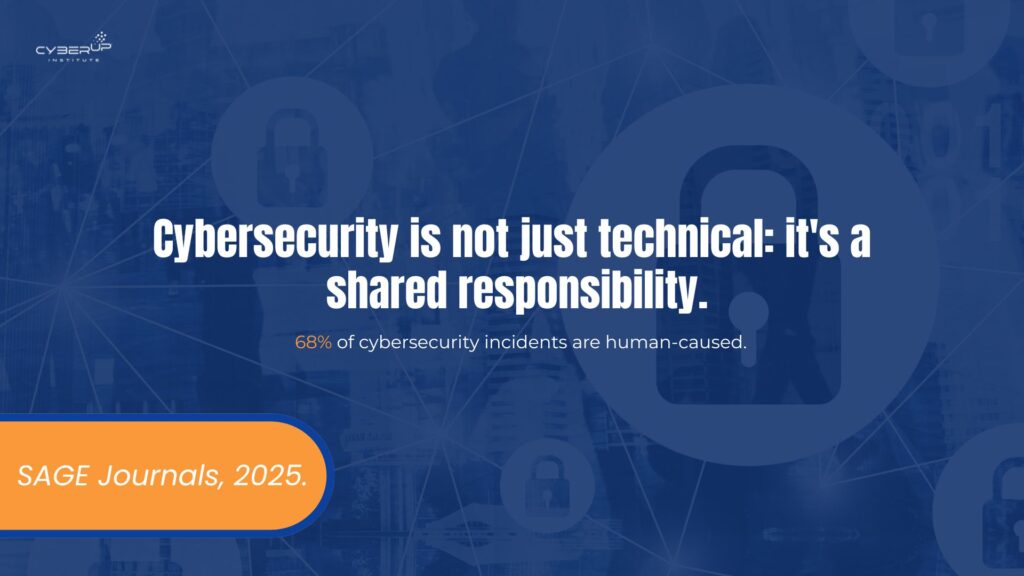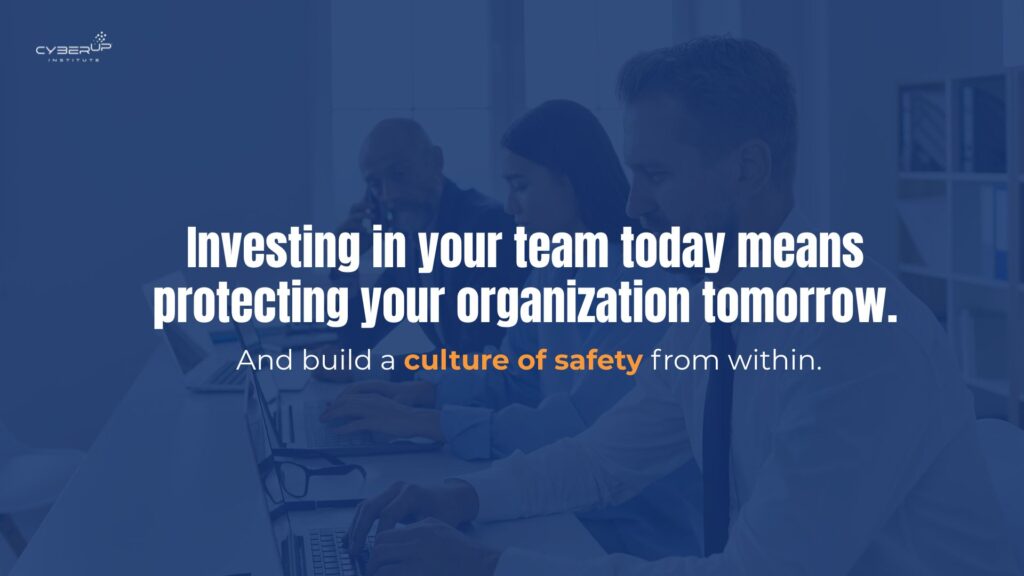Index
ToggleDigitalization has enabled companies and institutions to operate with greater efficiency, scalability, and connectivity. However, it has also increased their exposure to cyber threats that extend far beyond IT departments. Ransomware, phishing, and data breaches are no longer just technical issues — they are corporate risks with a direct impact on an organization’s reputation, productivity, and regulatory compliance.
In this context, hiring a cybersecurity specialist is no longer enough. Cybersecurity must be understood and implemented at the organizational level, from top leadership to operational teams. To achieve this, it’s essential to train all personnel with content tailored to their roles and responsibilities.
This article explains why cybersecurity is a collective responsibility, what skills your team needs, and how CyberUP Institute can help you design an effective, scalable training plan aligned with your operational goals.

Why Should Organizational Cybersecurity Be a Priority for All Teams?
In any modern institution — whether a business, public administration, or international organization — digital processes run through all operational areas. HR handles sensitive information. Finance uses systems connected to banks and suppliers. Communications teams constantly interact with external platforms and networks. Infrastructure security no longer depends on a single department — it depends on how every team handles, shares, and protects data.
Moreover, today’s cyberattacks do not only target technical failures but also human errors, poorly managed access, and gaps in accountability. This means that anyone, regardless of their role, can either become an entry point for an attack… or a key line of defense.
According to the World Economic Forum, nearly 70% of organizations believe that the shortage of professionals with the necessary — not just technical — skills has increased their exposure to cyber risks. This highlights the urgency of implementing an organizational security strategy that includes all internal stakeholders.
Training your entire team in cybersecurity is not optional — it is a structural necessity. Educating staff is as important as updating systems. Doing so across departments, with role-specific content, turns a security policy into a real and sustainable institutional practice.
Who Should Receive Cybersecurity Training?
Short answer: everyone. But not everyone needs to learn the same things. The key is to tailor training to each role, its functions, and its level of risk exposure. For example:
- Administrative staff: must learn to identify phishing attempts, protect sensitive documents, and manage access securely.
- Finance and legal departments: need training in data protection, electronic fraud, regulations such as GDPR, and digital audit standards.
- Technical and development teams: require advanced training in vulnerability detection, traffic analysis, secure network configuration, SIEM usage, and forensic tools.
- Executives and middle managers: should understand strategic risks, regulatory compliance, and how to align cybersecurity with business goals.
This type of differentiated yet organization-wide training reduces risk without disrupting daily operations and increases collective awareness of the value of security. At CyberUP, this segmented approach is the foundation of all training programs: it’s not just about teaching — it’s about tailoring knowledge to each organizational role.
Discover CyberUP’s Awareness courses (for staff, managers, and technical personnel) and take your organization to a new level of shared security.

How to Structure an Effective Cybersecurity Training Plan
A successful cybersecurity training strategy isn’t about offering a generic course once a year. To be effective, it must include:
- Baseline assessment: What does each group already know? What specific risks do they face?
- Customized content: Adapted to the role, technical level, and department.
- Practical training: Including simulations, real exercises, and secure training environments.
- Results tracking: Monitoring attendance, participation, test performance, and risk indicators.
- Continuous updates: Threats evolve, and training must evolve with them.
CyberUP supports organizations throughout this process — from the initial diagnosis to the implementation of learning paths and the delivery of impact reports. You can design a tailored training plan, with practical labs and certified programs. Explore the Cybersecurity Technician and NetOps courses for technical teams.
Tangible Benefits of Training Your Entire Team
An organization that invests in cybersecurity training doesn’t just reduce risk — it improves overall performance. Some of the most concrete benefits include:
- Fewer incidents caused by human error.
Numerous studies show that awareness sessions and role-specific training significantly reduce the likelihood of employees falling for phishing scams or mismanaging passwords. According to IBM, these efforts can reduce the average cost of a breach by millions of euros by preventing unauthorized access or loss of confidential data. - Greater compliance and audit readiness.
Regulations like GDPR, ISO/IEC 27001, and the NIST framework emphasize the need for trained staff aware of their responsibilities. In fact, ISO/IEC 27001 explicitly requires appropriate and ongoing employee training as part of its information security controls. In many sectors, continuous training is not optional — it is a requirement for passing audits and avoiding regulatory penalties. - Reduced operational and financial impact in case of an incident.
A trained team knows how to respond to threats, which shortens response time, limits damage, and prevents critical mistakes. This translates into business continuity and lower financial exposure. - A stronger and more proactive organizational culture.
According to the World Economic Forum, one of the most effective ways to close the cybersecurity skills gap is to develop internal capabilities through team-wide training.
Rather than centralizing knowledge in one department, organizations that train all staff foster a culture of shared responsibility — a cornerstone of any organizational cybersecurity strategy — where every team member knows they play an active role in digital protection.
How Can CyberUP Help?
At CyberUP, we design training programs tailored to the real needs of organizations. We don’t offer generic solutions: we build learning paths by level, focused on:
- Raising awareness and responsiveness among non-technical staff.
- Strengthening technical team skills through real tools and simulations.
- Supporting IT leaders in integrating training into the broader organizational strategy.
- Delivering measurable results, progress reports, and actionable recommendations.
Cybersecurity training should not be seen as just another expense — it’s a strategic investment in resilience, reputation, and performance.

Conclusion: The Best Defense Starts with Your Team
An organization’s security doesn’t just depend on its systems — it depends on the everyday behavior of those who use them. In an increasingly exposed digital environment, training your entire team in cybersecurity is no longer optional — it’s an urgent necessity.
CyberUP can help you build that shared knowledge base that protects your organization from within. With hands-on training, relevant content, and a flexible approach, we give you the tools to make your team not the weak link — but your first line of defense.
